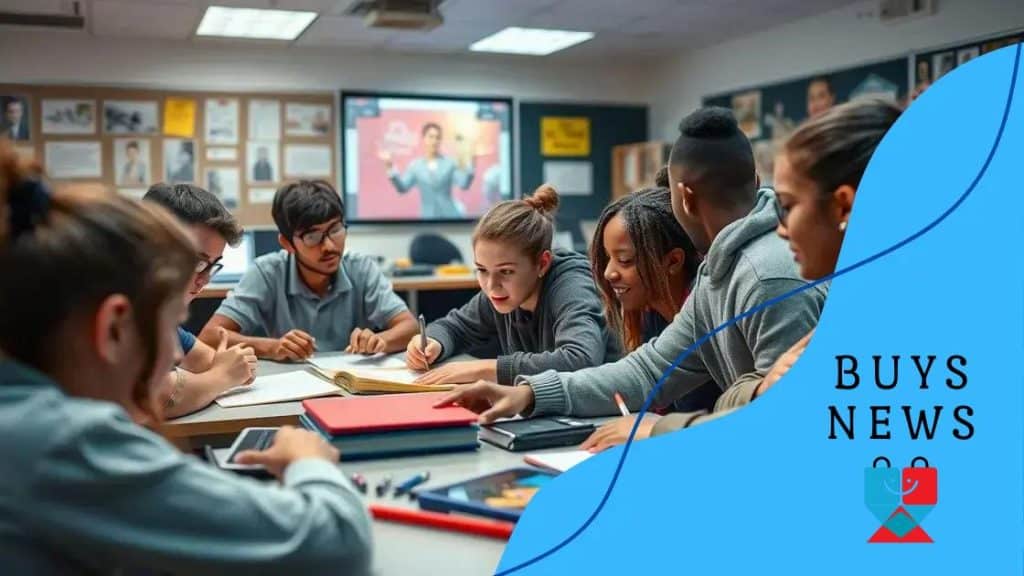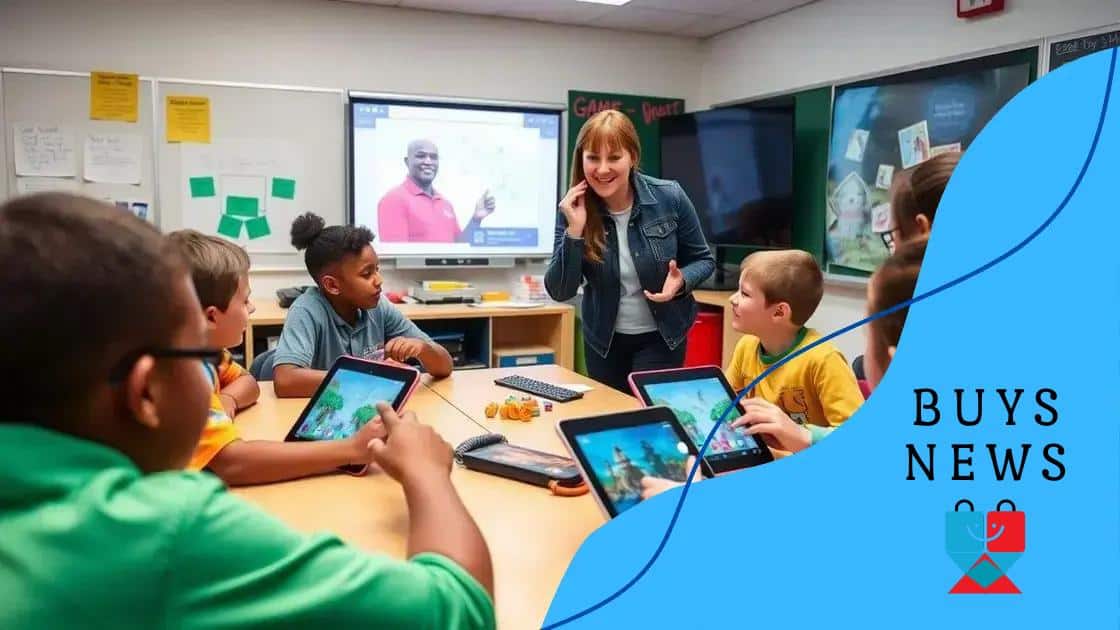Gamification in education: unlocking student potential

Gamification in education enhances student engagement and learning by incorporating game elements, which motivates students, promotes collaboration, and improves retention of information.
Gamification in education is transforming how we engage students in the learning process. Have you ever wondered how game elements can enhance motivation and retention? Let’s dive into this exciting approach!
Understanding gamification in education
Understanding gamification in education is crucial for creating engaging learning environments. It involves using game elements to enhance the educational experience, making learning more interactive and fun.
One significant aspect of gamification is its focus on motivation. By integrating game mechanics, educators can foster a sense of accomplishment and competition among students. This can lead to increased participation and better retention of information.
Key Components of Gamification
To effectively implement gamification in education, it’s essential to understand its key components:
- Rewards: Providing points, badges, or prizes for achievements encourages students to engage more.
- Challenges: Incorporating challenges helps students develop problem-solving skills.
- Feedback: Immediate feedback helps learners understand their progress.
- Storytelling: Creating a narrative can immerse students in the learning experience.
Consequently, the integration of these components into lessons can make learning enjoyable and impactful. Another fascinating element is how gamification promotes collaboration. Students often work in teams, which boosts communication skills and teamwork.
Furthermore, utilizing technology in the classroom is becoming increasingly vital. Many educational platforms now incorporate game-like elements, making it easier for educators to integrate these strategies into their curriculum. With interactive apps, students can learn at their own pace while still feeling supported and challenged.
Benefits of gamification for students
The benefits of gamification for students are vast and impactful. By incorporating game-like elements into learning, students can enjoy a more engaging experience that enhances their educational journey.
One of the primary advantages is increased motivation. Gamification provides students with challenges and rewards that make learning fun. When students earn points or badges for completing tasks, they feel a sense of achievement, encouraging them to participate more willingly.
Enhanced Learning Experience
Another significant benefit is the improvement in the overall learning experience. Gamified lessons often include interactive elements that capture students’ attention. These activities can help to:
- Encourage Active Participation: Students become more involved in their learning.
- Facilitate Better Retention: Game mechanics reinforce information, making it easier to remember.
- Promote Problem-Solving Skills: Students learn to think critically and solve problems in a fun environment.
Additionally, gamification fosters collaboration among peers. Students often work together in teams to achieve common goals, which helps to build communication skills and a sense of community. This aspect is particularly beneficial because it prepares students for real-world relationships and teamwork.
Technology plays a pivotal role in the gamification process. Many educational platforms offer digital games that align with educational standards, allowing students to learn while having fun. These platforms often track progress and provide feedback, helping students to identify areas for improvement.
Furthermore, gamification can cater to various learning styles. Visual learners may benefit from game graphics, while kinesthetic learners can engage through interactive tasks. This inclusivity allows all students to find enjoyment in the learning process, promoting a more positive classroom environment.
Effective strategies for implementing gamification

Implementing gamification effectively requires careful planning and consideration. By using specific strategies, educators can create a more engaging and successful learning environment.
One effective strategy is to set clear goals. When students know what they are working toward, it enhances their motivation. Establishing specific objectives ensures that everyone is on the same path and understands the expected outcomes.
Utilize Technology
Incorporating technology is another key strategy. Many platforms offer tools designed to integrate game elements seamlessly into lessons. These tools can track progress and provide immediate feedback, making it easier for both teachers and students to monitor achievements.
- Choose Suitable Platforms: Select platforms that align with educational goals.
- Incorporate Interactive Activities: Use quizzes, leaderboards, and challenges to make learning fun.
- Offer Rewards Systems: Create systems that recognize student achievements to keep them motivated.
Another important aspect of successful gamification is to tailor the approach to different learning styles. Understanding that students learn differently allows for a more inclusive environment. For example, visual learners may benefit from animated content, while hands-on learners might engage better with interactive simulations.
Furthermore, fostering collaboration among students can enhance the gamified experience. Encourage team-based tasks that require students to work together to achieve goals. This not only builds communication skills but also creates a sense of community within the classroom.
Lastly, regularly evaluate and adapt gamification methods. Gathering feedback from students can identify what works and what doesn’t. This continuous improvement approach ensures that gamification remains effective and relevant.
Case studies of successful gamification
Examining case studies of successful gamification provides valuable insights into how this approach can enhance education. Many schools and organizations have implemented gamification and seen impressive results.
One notable case is a high school in California that integrated gamification into its science curriculum. Teachers introduced a points system where students earned points by completing assignments, participating in discussions, and achieving high test scores. As a result, student engagement increased significantly, and grades improved overall.
Real-World Examples
Another remarkable example comes from a university that used gamification in its online courses. Students participated in a game-like platform where they could track their progress, collaborate with peers, and compete for badges. The outcome was a noticeable boost in course completion rates and student satisfaction.
- Increased Engagement: Students felt more motivated to complete tasks.
- Higher Retention Rates: Gamification helped students remember information better.
- Enhanced Collaboration: Working together in teams promoted teamwork and communication.
In addition to these educational settings, gamification has also been effective in corporate training programs. Companies have adopted gamified learning to enhance employee engagement during training sessions. One tech company, for instance, developed a gamified onboarding process that rewarded new employees for completing training modules and participating in team-building activities.
This approach not only made the training fun but also helped new hires feel more connected to their teams. By sharing their experiences with rewards and progress, employees quickly adapted to company culture.
Furthermore, gamification has shown to be beneficial in non-profit organizations. A charity introduced a gamified fundraising campaign that encouraged donors to compete for prizes based on their contributions. This innovative approach led to a significant increase in donations, demonstrating that gamification can effectively drive engagement and participation.
Challenges and considerations in gamification
While gamification has many benefits, it also comes with challenges and considerations that educators must navigate carefully. Understanding these obstacles is essential for effective implementation.
One major challenge is ensuring that gamified elements genuinely enhance learning rather than distract from it. When students are too focused on earning points or badges, they might overlook the primary educational goals. This can lead to a superficial understanding of the material.
Balancing Competition and Collaboration
Another critical consideration involves the balance between competition and collaboration. While a certain level of competition can motivate students, excessive rivalry might create stress and anxiety. It’s important to foster a supportive environment where teamwork is encouraged alongside competition.
- Avoid Overemphasis on Rewards: Focus on intrinsic motivation instead of just extrinsic rewards.
- Monitor Student Progress: Regularly assess if gamification enhances understanding.
- Encourage Team Participation: Develop team-based goals to promote collaboration.
In addition to these aspects, technology can be a double-edged sword. Many gamified solutions rely heavily on technology, which may not be equally accessible to all students. Ensuring that all students can participate fully can be challenging, particularly in under-resourced settings.
Furthermore, teachers need to be adequately trained to implement and manage gamified learning environments. They must understand both the technology and the pedagogical approaches necessary to make gamification effective. Without proper training, there’s a risk of misusing gamification, which can lead to frustration for both teachers and students.
Lastly, evaluating the effectiveness of gamified strategies is crucial. Continuous feedback loops help educators understand what works and what doesn’t. This adaptability is vital for creating a sustainable and effective gamified classroom environment.
FAQ – Frequently Asked Questions About Gamification in Education
What are the main benefits of gamification in education?
Gamification increases student engagement and motivation while promoting collaboration and critical thinking.
How can challenges in gamification be addressed?
Challenges can be addressed by balancing competition and collaboration and ensuring that gamified elements enhance learning.
What role does technology play in gamification?
Technology is crucial for implementing gamification, but it’s important to ensure all students have equal access to these resources.
How can teachers evaluate the effectiveness of gamification?
Teachers can gather feedback from students and monitor progress to adapt and improve their gamified teaching strategies.





